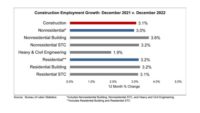Construction employment increased in 268 or 75% of 358 metro areas between October 2021 and October 2022, according to an analysis by the Associated General Contractors of America of new government employment data. Association officials noted, however, that job vacancies outpaced hiring as construction firms struggle to find enough qualified workers to hire.
“While three out of four metros added construction jobs in the past year, gains would have been even more widespread if contractors could find enough qualified workers,” said Ken Simonson, the association’s chief economist. “Job openings at the end of September topped the number of construction employees hired all month, implying that contractors wanted to hire more than twice as many workers as they were able to find.”
There were 412,000 job openings in construction at the end of September, which exceeded the 348,000 employees hired during the month, said Simonson. He added that industry’s unemployment rate was only 4.1%, indicating there were few individuals with construction experience available to hire.
Houston-The Woodlands-Sugar Land, Texas added the most construction jobs (26,000 jobs or 12%), followed by Dallas-Plano-Irving, TX (14,300 jobs, 10%); Seattle-Bellevue-Everett, WA (11,000 jobs, 10%); and Anaheim-Santa Ana-Irvine, CA (8,700 jobs, 8%). Provo-Orem, UT had the largest percentage gain (21%, 6,100 jobs), followed by Danville, IL (17%, 100 jobs); Kansas City, MO (16%, 5,000 jobs); and Beaumont-Port Arthur, TX (15%, 2,500 jobs).
Construction employment declined over the year in 47 metro areas and was unchanged in 43 areas. The largest job loss occurred in Orlando-Kissimmee-Sanford, FL (-6,800 jobs, -8%), followed by Baton Rouge, LA (-5,000 jobs, -11%); Richmond, VA (-2,800 jobs, -7%); and San Antonio-New Braunfels, TX (-2,800 jobs, -5%). The largest percentage decline was in Baton Rouge, followed by Orlando-Kissimmee-Sanford; Bergen-Hudson-Passaic, NJ (-7%, -2,200 jobs); and Richmond, VA.
Association officials urged Congress and the Biden administration to work together to address construction labor shortages that threaten to undermine new economic activity and infrastructure upgrades. They said measures to allow more work visas for construction positions would provide short-term relief. They also pushed for new investments in construction training and education programs to rebuild the domestic pipeline for workers.
“Instead of urging every student to attend college, amass debt and seek loan relief, public officials should show future workers there are multiple paths to success, including in construction,” said Stephen E. Sandherr, the association’s chief executive officer. “It is time to start investing in the kind of workforce training and education that will allow more Americans to pursue a high-paying construction career.”

.jpg?height=200&t=1644326835&width=200)

